Do California Smog Technicians Visually Inspect the Oxygen Sensors During a Smog?
Summary:
California’s smog inspection program is one of the strictest in the country, with a strong focus on ensuring all emissions-related components are present and functioning properly. This includes oxygen sensors. In this article, we explain how smog technicians conduct visual inspections, whether they specifically check O2 sensors, and what this means for vehicle owners using or considering modifications like O2 sensor spacers.
Table of Contents:
-
Overview of California Smog Checks
-
What Is a Visual Inspection?
-
Do Smog Technicians Inspect Oxygen Sensors?
-
How O2 Sensor Spacers Get Flagged
-
What Happens If Your O2 Sensor Setup Fails Inspection?
-
Common Reasons for O2 Sensor-Related Failures
-
How to Pass Smog Legally With Aftermarket Exhaust Mods
-
Summary: Smog Inspections and O2 Sensor Checks
-
FAQ
1. Overview of California Smog Checks
California requires periodic emissions inspections for most gasoline-powered vehicles. The program includes:
-
Visual inspection of emissions equipment
-
Functional check of the onboard diagnostic (OBD II) system
-
Tailpipe emissions testing (in some cases)
2. What Is a Visual Inspection?
A visual inspection involves verifying the presence and apparent functionality of all mandated emissions components. Technicians look for:
-
OEM or CARB-approved parts
-
Tampering or unauthorized modifications
-
Missing sensors or components
3. Do Smog Technicians Inspect Oxygen Sensors?
Yes. Smog technicians are trained to visually confirm:
-
All O2 sensors are present in factory or approved locations
-
No evidence of spacers, extenders, or bypass devices
-
Wiring and connectors are intact and unmodified
If the O2 sensor setup appears altered or includes non-approved components, the vehicle may fail the visual inspection—even if emissions pass and no codes are present.
4. How O2 Sensor Spacers Get Flagged
O2 sensor spacers are often easy to spot because they protrude between the sensor and the exhaust bung. Technicians may flag your vehicle if:
-
The spacer looks aftermarket or non-OEM
-
The part lacks a CARB Executive Order (EO) number
-
The sensor is clearly offset from its original location
5. What Happens If Your O2 Sensor Setup Fails Inspection?
If your vehicle fails due to an illegal O2 sensor modification:
-
You’ll receive a failed smog report
-
You must remove the non-compliant part and retest
-
Some test stations report repeated violations to BAR (Bureau of Automotive Repair)
6. Common Reasons for O2 Sensor-Related Failures
-
Use of unapproved O2 spacers or extenders
-
Sensor relocation without CARB documentation
-
Visible signs of tampering or defeat devices
-
Damaged or cut sensor wiring
7. How to Pass Smog Legally With Aftermarket Exhaust Mods
To stay compliant:
-
Use only CARB-approved parts with EO numbers
-
Keep sensors in factory locations unless specified by EO
-
Avoid any part marketed to "trick" or "bypass" emissions monitoring
-
Perform a pre-inspection scan to check readiness monitors and fault codes
8. Summary: Smog Inspections and O2 Sensor Checks
| Inspection Element | Checked by Tech? | Notes |
|---|---|---|
| O2 Sensor Presence | Yes | Must match factory or EO specs |
| Spacers or Extenders | Yes | Usually results in failure |
| Sensor Wiring | Yes | Must be intact and unmodified |
| CARB EO Verification | Yes | Required for aftermarket parts |
9. FAQ
Q: Will a smog technician remove my sensor to check for a spacer?
A: No, but if a spacer is visible or obvious, it will be flagged.
Q: Can I pass smog with an O2 spacer?
A: Not legally. Even if you pass emissions, a visual inspection failure means you won’t get certified.
Q: Are O2 sensors always checked in smog tests?
A: Yes. Presence, location, and condition are part of the inspection checklist.
Q: What should I do if I have aftermarket exhaust components?
A: Ensure they are CARB-certified and maintain all O2 sensors in approved configurations.


![ Fix P0420 Fast: Do O2 Sensor Spacers Really Work? [Legal Tips Inside]](http://ghalysmotorparts.com/cdn/shop/articles/ChatGPT_Image_Oct_10_2025_10_40_32_AM.png?v=1760118069&width=360)
![Do O2 Sensor Spacers Really Help Clear the P0420 Code? [Expert Guide]](http://ghalysmotorparts.com/cdn/shop/articles/ChatGPT_Image_Oct_9_2025_09_28_33_PM_654c1798-c0d4-428f-a5b6-f20b95661b54.png?v=1760129952&width=360)


